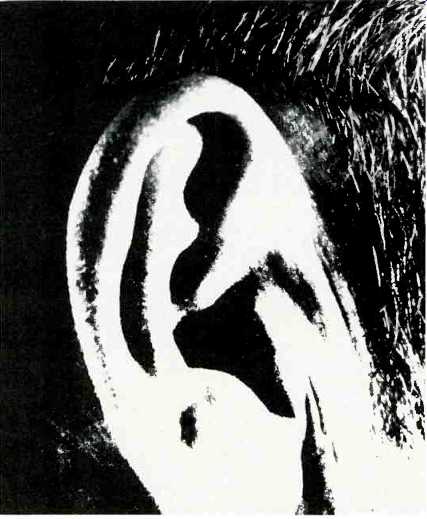
By Martin Clifford
THERE'S NOTHING BETTER than the onset of well-deserved sleep that succeeds a hard day's work. But, given a quiet enough room, with outside and inside noise down to a minimum, then the malicious intent of a single mosquito humming its act of vengeance will be noticeable in the sense that you'll hear it. The sound power output of this insect, beside which a bee is a behemoth, is maximum at the source and might represent a microwatt, a millionth of a watt, or less. But that is at the source. Lying prone, some six or eight feet away, the sound decreases to a fraction of its original amount. It is difficult to say by how much since high pitched sounds, in traveling through air, decrease in strength much more rapidly than low-pitched sounds. And the mosquito is quite far removed in pitch from the bass tones of a pipe organ. And so what does alert you is a sound power of a fraction of a millionth of a watt.
Thinking in the other direction, you might turn on your hi fi system so the sound level reaching your ears is about 1 watt. Purely on the basis of these unscientific revelations, your hearing has a sound power range of more than a million. Actually, the power range of human hearing has a factor of several million or more, from sounds that are barely perceptible under ideal hearing conditions to the point at which they become somewhat painful.
The Loudness Of Sound
The loudness of sound is a measure of the intensity of the sound. Loudness levels are described in terms of decibels, abbreviated as dB. If you want to take 0 dB as your reference level, that would be the end of your auditory yardstick at which you might just barely hear sound, but wouldn't be too sure about it. Down at 0 dB you might become conscious of the noise of your own breathing and your heart beat interfering with this test.
Someone trying to attract your attention and whispering to you from about five feet away might produce a sound intensity of 10 dB. An auto in good condition about twenty feet away might raise sound pressure to 50 dB. On a Saturday afternoon your supermarket is probably around 60 dB and so if you and a friend are shopping talking, the conversation is being carried on at around 70 dB. Pneumatic street drills, steel girder riveting, and on-ground nearby jet engines can push sound pressure up to 90, 100 or more decibels. At which point you should leave, cover your ears, or stuff them with cotton, for you are at the threshold of pain.
Now let's translate this in terms of audio power. 10 watts isn't all that much: most amplifiers and speakers today have much higher ratings. And yet if you have a listening position of about 10 feet from a speaker system utilizing 10 watts of audio power you will have passed the threshold of pain, or somewhere between 100 and 120 dB, depending on the characteristics of your own hearing mechanism. That's not too surprising, though, since you are listening to a sound power level that's many millions of times greater than the mosquito we started with.
Sound Characteristics
We live at the bottom of an ocean of air, walking through it, breathing it, polluting it, pushing it. And when we disturb it we get sound. But air consists of molecules, and so we get sound by upsetting their random scattering behavior, compressing them at times, rarefying or separating them at others.
It may seem difficult to categorize such a situation, but we can and we do.
Sound has three dependable characteristics: loudness, pitch, and quality.
Working backward, the quality of a sound depends on the number of overtones or harmonics. The pure tone of a pitch pipe sounds dispirited compared to the richness of the human voice at the same tone, harmonic laden. Pitch is determined by the frequency of the sound wave and the larger the number of sound vibrations per second, the higher the pitch. Listening pitch range depends upon a person's age, sex, health, disposition to tell the truth about hearing ability, and the loudness of the sound. It can extend from 20 Hz to 15,000 Hz, but is probably in a narrower range for most people.
Many people can hear up to 10,000 Hz, with those having a hearing ability above 10,000 and going to 15,000 or possibly 20,000 Hz becoming a select crew. Down at the other end, the problem is twofold. Once we get below about 50 Hz, it is very difficult to get pure tones. Thus, if you're listening to the low-down pipes of an organ, what you think may be 30 Hz, is more probably the second harmonic, or 60 Hz. In listening to a complex tone, it is entirely possible for the fundamental to be inaudible. What we hear will be harmonics. Loudness is another factor. You might be able to hear a pure tone of 30 Hz if it were loud enough. And so one of the characteristics of human hearing is that we need more sound power down at the low-frequency and to be able to hear the lows in proper proportion to the rest of the audio range. You can test this yourself with an ordinary, non-sophisticated, non hi fi receiver. Tune in a station with a thumping good bass and make sure the volume control is way up. Now turn down the control for `quiet' listening and you'll find the bass has practically disappeared. It isn't that the volume control has preferential militancy against bass. Blame it on your ears.
That's why, in an orchestra suddenly reaching a pianissimo passage, the man with the bull fiddle doesn't have to decrease his sound output as much as the artist with the piccolo. And while we're with this orchestra, you might note that the difference in dB between the softest and loudest passages is the dynamic range.
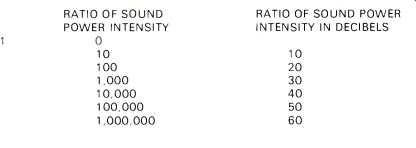
Fig. 1--A comparison of sound power or sound intensity and the corresponding
change in decibels.
Fig. 1A--A comparison of sound power or sound intensity and the corresponding change in decibels.
Some Sound Differences
The sensitivity of the ear to loudness isn't all that simple, for it depends .on both pitch and the sound power level. And a certain increment in sound power is required before we can perceive that a change has been made. If, for example, you are whispering at a sound level of 5 dB and raised your voice by just 1 dB, the difference would not be noticed. It is because a definite percentage increase in sound intensity is required before a change can be noticed that we use the decibel whose value represents the smallest loudness change we can be aware of in the middle range of sound frequencies. As an example, assume we have two tones at the same pitch.
If these two tones differ by three dB, the second will have twice the power of the first, hence will sound twice as loud. If we go to 6 dB, the second tone will sound four times as loud. In effect, we get a doubling of sound loudness for each 3 dB increase. The decibel, then refers to a difference in the level of sound intensity. A decibel is a comparison unit. And because this is' what it is, it has no name, such as those we assign to other units of measurement--6 inches, 20 gallons, etc.
If you insist on a definition, a decibel is a logarithmic comparison or ratio between two power levels. Logarithmic, not because we want to make things difficult for hi fi listeners, but because that is the way the human ear responds to sound pressure levels.
Figure 1 is a table that compares the ratio of the intensities or the powers of two sounds and that same relationship expressed in decibels. Note, in the column at the left, if we increase sound intensity by a multiplication factor of 10, the decibel change is simply an increase (not a multiplication) of 10. If, for example, you have an amplifier with an output of just I watt and decide to exchange it for a unit with an output of 100 watts, what you will gain will be 20 decibels, or the logarithmic ratio between 100 and 1. It takes a gain of 1,000,000 to 1 to get a gain of 60 dB. Figure 1 also shows that if you start with a 1 watt output and go to 10 watts, you will need to go to 100 watts, to get the same dB increase. However, if you are already at 100 watts (and the amplifiers in many receivers and power amps do have such a rating), then you would need to go up to 1,000 watts, 1 kilowatt, before getting another 10 dB increase.
When Is a Watt Not a Watt?
An amplifier with a power output of 10 watts can drive you out of your room and skull. And yet, if you have an amplifier with a power output of 50 watts (and if, theoretically, you could listen to it) you would not notice the difference if you increased the power output by an additional 10 watts, going from 50 to 60. 10 watts in both instances, with one that is ear shattering and the other barely noticeable. The answer is in the word difference. In the first you might be going from 1 milliwatt, or a thousandth of a watt, a change of 40 dB. In the second example, the change would be from 50 to 60 dB, and the ratio here (60 divided by 50) is about 1.2 dB, and that amount of change is hardly noticeable.
Loudness Vs Pitch
Loudness is sound pressure; pitch is frequency. If you have two tones of the same frequency, it takes about 3 dB for the second tone (still of the same frequency) to sound twice as loud as the first. In terms of power output, assume the first amplifier has an output of 10 watts with 1 watt of signal driving power. The output in dB is 10. Still using a tone of the same frequency, and the same amount of signal driving power, the second amplifier could have an output of 20 watts, or twice as much power output as the first. The output would be 13 dB. A 100% increase in power output in this example results in a tone that sounds approximately twice as loud.
But extremely few compositions are written for single tones. Even that perennial favorite of the novice pianist, "chopsticks," does have some tonal variation. The saving grace is that the ear is extremely sensitive to changes in pitch. In the middle regions of the sound scale, a change in pitch of only three tenths of one percent is generally noticeable. And so, while sound must literally blast us out of our listening seats to get our attention that a change of sound pressure or loudness has taken place, just a slight movement up or down the musical scale flashes a warning signal to our listening apparatus.

Fig. 2-The loudness control compensates for deficiencies in human hearing
at low levels at the extremes of the listening range.
Loudness vs Volume Controls
On the front of your receiver or power amp you will find two controls, one identified as loudness, the other as volume. The function of the volume control is obvious. It controls sound power output so that what you hear covers the range from oh so quiet to tympanum shaking. The loudness control, sometimes called loudness contour, and not to be confused with the volume control, governs a circuit which counteracts the reduced sensitivity of the ear to very low and high notes at low volume levels. The loudness control which compensates for the way the human ear behaves, boosting extreme sound ranges at low volume settings.
And so, if you have your volume control turned up, switch the loudness control to its off position. Fig. 2 is a graph that shows the behavior of the loudness switch. In the midrange it has no effect, but it compensates for our hearing rolloff down at the bass and up at the treble ends.
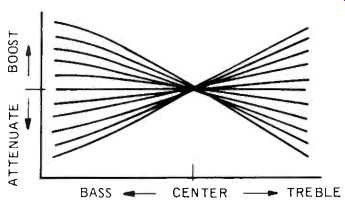
Fig. 3--Frequency characteristics of a CR type tone control.
Volume vs Balance Controls
The purpose of the balance control is to govern the amount of sound coming from left-right speakers.
Without this control you would need to position yourself rather precisely to get optimum stereo effect from your two speakers. The balance control lets you sit to the right or left of center and to compensate, not only for your position, but for the fact that the two speakers might have different efficiencies. The balance control, of course, is nothing more than a special purpose volume control. However, the balance control doesn't work quite the way you might think it does. If you turn it to the right, it doesn't increase right channel volume but actually reduces left-channel volume. It's all relative, anyway.
Tone Controls
Unless you are a juke box aficionado and have an unsatisfied desire for strong bass, or if you have a predilection for treble, the best place to keep the tone controls is in their 'flat' position, clearly marked on the panel of your receiver or power amp.
Tone controls are best used sparingly and their constant manipulation indicates a form of nervous apprehension not curable by music. The purpose of the bass and treble controls isn't to supply the owner of the power amp with some kind of musical dictatorship, but to compensate for the listening room, or possibly for the speakers, to overcome minor deficiencies in the recorded material, or to satisfy the idiosyncrasies of a pair of ears. With good, new LP records or tapes played on good equipment in a representative listening room, extreme tone control settings are almost never required.
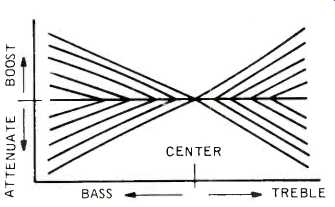
Fig. 4--Frequency characteristics of a NFB type tone control.
In its simplest, bargain basement form, as found on portable radios, a tone control is just a combination of a capacitor with a resistance. A tone control of this type doesn't boost anything. It makes bass sound stronger, but does so by cutting down on treble.
More suitable to hi-fi applications is the CR type tone control (Fig. 3) which boosts or reduces frequencies above and below a turnover point.
For even more precise, active control, negative feedback techniques are used.
Known as an NFB type tone control, it requires rather elaborate solid-state circuits. Fig. 4 shows the frequency response characteristics.
On some amplifiers, the tone controls work on the left and right stereo channels simultaneously, while others may have separate controls, usually concentric double knobs for governing the left and right channels separately, advantageous when your listening room presents some acoustic problems.
Filters
The word `filter' is possibly an unfortunate choice for it connotes an improvement or a greater obtainable purity with its use. Alas, not so. The purpose of a filter is to attenuate low or high (or both) sound frequencies.
Low and high filters, sometimes labeled as rumble or bass filters and noise or scratch filters, respectively, on hi fi equipment, have functions as shown in the curves of Fig. 5. The bass filter is designed to cut off, or more precisely, to attenuate by so many dB, the sound spectrum below a certain point, generally somewhere between 100 and 50 Hz. This is particularly useful if you have a turntable that generates some hum and rumble.
Note this isn't a particularly good technique, because the price you pay is the elimination, or, at least, the attenuation of a part of the musical spectrum. If your equipment works best with the bass filter set in its maximum position, it would be advisable to consider a cure.
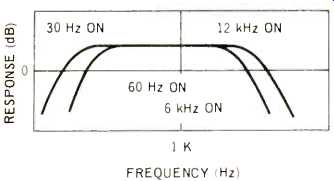
Fig. 5--Filter characteristics.
The high filter attenuates frequencies above 8,000 to 10,000 Hz to eliminate scratching and hiss from records, tapes or FM reception. Again, you pay a price in the loss of sound you should be hearing. Tape hiss can be cut down quite a bit by the use of a Dolby unit which you can incorporate into your present hi fi system, or, if you haven't as yet bought your cassette or open reel unit, just make sure they are `Dolbyized'. As far as record noise is concerned, it is the better part of hi fi valor to make sure your discs are clean, that your stylus is not only clean but in good condition, and that tracking pressure is correct. Using your scratch filter as a substitute is an easy, but not a good way, out. The ideal position for filters is in the 'off' position.
Crossover Networks and Level Controls
The purpose of telling you about loudness, volume and tone controls is to show you that we don't have to accept sound as it is. We can manipulate it and shape it, as though it were just so much malleable clay.
And if, as a purist, you think this is a terrible thing to do, consider the effect you have on sound every time you move around a room, or what you hear `live' depends on where you sit, and on your musical training, and on the state of health of one ear versus the other. Not all soup tastes best unseasoned.
It is true that during the manipulative process of setting filter, loudness and volume controls the sound is still in the form of an electric current, but you can also change it when it emerges as sound energy just by shifting speaker positions or altering the acoustic contour of your listening room by adding some throw cushions or removing a rug.
We changed sound to suit personal tastes. And as musical tastes change, there may come a preference for sound that more closely resembles the original. Call it musical sophistication.
Sound can not only be modified, but split as well. Your speaker systems contain crossover networks and quite possibly one or more level controls.
(Fig. 6). Crossovers are electronic circuits that split the sound spectrum into low and mid/high range for 2-way systems, low, mid- and high- for 3-way.
Ordinarily, the crossover consists of coils and capacitors, with the coils as ferrite types. The border frequencies at which sound ranges are continuous are called crossover points. (Fig. 7)
Because they are not tunable, they do not always deliver equal response in each sound range.
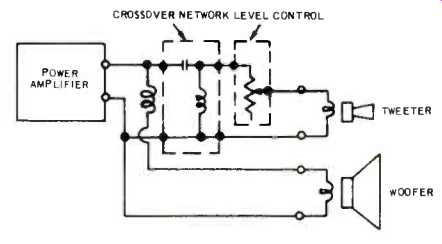
Fig. 6--Crossover network and level control.
The level control is a ‘kissin cousin' of the volume control and works the same way. It consists of a variable resistor, a potentiometer or 'pot' which dissipates part of the signal.
And so, it is just a simple attenuator which allows the medium or high sound ranges to be suppressed or boosted to a limited extent a helpful way of matching the speaker response to the acoustics of your listening room.
That word 'boosted' though, is a misnomer. No resistive network, acting alone, ever boosts anything. It just sounds as though it does. All it can do is to weaken one part of the sound spectrum relative to some other part.
But if your sound system has volume to spare, the price is quite small.
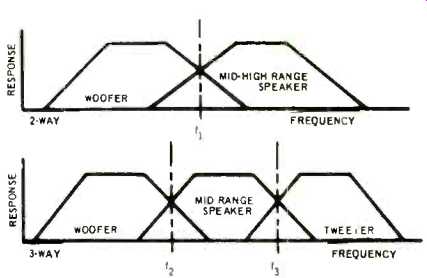
Fig 7--Graphs of 2-way and 3-way crossover networks; VI is the crossover for
the 2-way; f2 and f3 for the 3-way.
Noise
Sound doesn't always reach us in its original pristine purity. On its way to us from the FM station it can be sullied by other signals, both manmade and natural. Atmospheric noise, auto ignition noise, noise from inside fluorescents and outside neons, electrical noise from motors. That's still not all. The insidious enemy is at work right inside your hi fi system.
Currents produce noise when they flow through parts, such as resistors. Your record player is a combined music and noise maker. And, invisible though they may be, in your home you are surrounded by magnetic fields whose varying strengths enable them to induce hum voltages into your hi fi system. The sum of this electronic ecological disaster is grouped under one heading-noise. It consists of a mixture of random signals, plus all unwanted signals such as hum, hiss, rumble, interference and distortion.
Signal-to-noise ratio, abbreviated as S/N, is a comparison or a division--the amount of wanted signal divided by the amount of noise. The ideal is to make S as large as possible and drive N down to zero. The ratio is always given in dB. 50 dB is about a minimum requirement. A signal to noise ratio of 20 dB means the signal is 100 times as large as the noise.
With a ratio of 30 dB the signal is 1,000 times greater. When you get up to 60 dB, the signal is a million times as large as the noise. But if this is any solace to you, remember it takes just one small swimming fly to spoil a plate of soup.
In practice, s/n measurements are usually expressed as a voltage ratio. A s/n of 40 dB would be equivalent to a voltage ratio fo 100.
-ED.
( Audio magazine, Feb. 1973)
Also see:
The Language of High Fidelity--Part IX: Record Players (Mar. 1973)
The Language of High Fidelity--Part VII: The Basic High-Fidelity System (Dec. 1972)
Language of High Fidelity--Part XI (May 1974)
= = = =